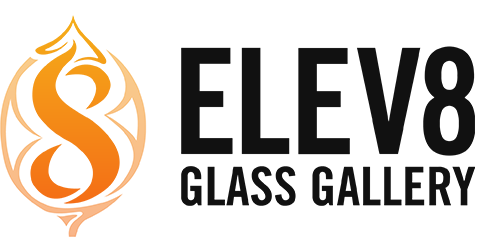No, each artist is unique for what they do. Each person that works at Elev8 has an opinion on who they like, but feel free to see all the artists we work with and see who you like best.
what is one of elev8s’ biggest influences?
Cannabis and Glass
Protected: Do elev8 glass artists get paid hourly?
That are the temperature ranges for the SSV?
The temps for the SSV can range from room temperature up to 500+ degrees. 450 is the combustion point of cannabis and if you run your SSV at full blast and inhale slowly you will achieve temperatures that will make the herbs combust. This is because sometimes with oils or hash one likes even higher temperature.
is your glass that isnt elev8, from china?
Elev8 Glass is either foreign or a hybrid of foreign and domestic glass.
Elev8 Premier glass is made in the USA using either foreign or domestic glass. Shott is the best boro and it comes from Germany. No one really knows where the cullet comes from to make the colored USA glass other than the manufactures.
what is the yellow stuff in the thermal bangers?
The yellow stuff is cadmium based borosilicate glass. This is safe. They are called thermochromatic bangers as well
Is the tubing / hose BPA free for the vaporizers by 7th Floor?
Yes
Are the Super Surfer vapor bags BPA Free?
Yes
When was glass invented?
The earliest known man-made glass are dates back to around 3500BC, with finds in Egypt and Eastern Mesopotamia. The discovery of glassblowing around 1st century BC was a major breakthrough in glass making.
What is glass
Glass is a non-crystalline, often transparent amorphous solid, that has widespread practical, technological, and decorative uses in, for example, window panes, tableware, optics, and optoelectronics. The most familiar, and historically the oldest, types of manufactured glass are “silicate glasses” based on the chemical compound silica (silicon dioxide, or quartz), the primary constituent of sand. The term glass, in popular usage, is often used to refer only to this type of material, which is familiar from use as window glass and in glass bottles. Of the many silica-based glasses that exist, ordinary glazing and container glass is formed from a specific type called soda-lime glass, composed of approximately 75% silicon dioxide (SiO2), sodium oxide (Na2O) from sodium carbonate (Na2CO3), calcium oxide (CaO), also called lime, and several minor additives.
Many applications of silicate glasses derive from their optical transparency, giving rise to their primary use as window panes. Glass will transmit, reflect and refract light; these qualities can be enhanced by cutting and polishing to make optical lenses, prisms, fine glassware, and optical fibers for high speed data transmission by light. Glass can be coloured by adding metallic salts, and can also be painted and printed with vitreous enamels. These qualities have led to the extensive use of glass in the manufacture of art objects and in particular, stained glass windows. Although brittle, silicate glass is extremely durable, and many examples of glass fragments exist from early glass-making cultures. Because glass can be formed or moulded into any shape, it has been traditionally used for vessels: bowls, vases, bottles, jars and drinking glasses. In its most solid forms it has also been used for paperweights, marbles, and beads. When extruded as glass fiber and matted as glass wool in a way to trap air, it becomes a thermal insulating material, and when these glass fibers are embedded into an organic polymer plastic, they are a key structural reinforcement part of the composite material fiberglass. Some objects historically were so commonly made of silicate glass that they are simply called by the name of the material, such as drinking glasses and eyeglasses.
Scientifically, “glass” is often defined in a broader sense, encompassing every solid that possesses a non-crystalline (that is, amorphous) structure at the atomic scale and that exhibits a glass transition when heated towards the liquid state. Porcelains and many polymer thermoplastics familiar from everyday use are glasses. These sorts of glasses can be made of quite different kinds of materials than silica: metallic alloys, ionic melts, aqueous solutions, molecular liquids, and polymers. For many applications, like glass bottles or eyewear, polymer glasses (acrylic glass, polycarbonate or polyethylene terephthalate) are a lighter alternative than traditional glass.
